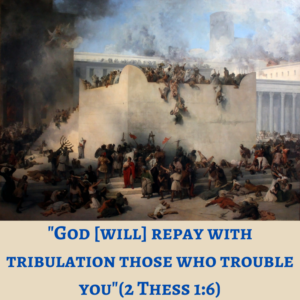
Christians need an optimistic view of God’s kingdom. We need to know that Christ’s opponents—including satanic conspirators who manipulate currencies, use COVID and its vaccinations for political purposes, and otherwise attempt to rule the world—will fail. False religions, and false doctrine within the church, also war against the kingdom of “our Lord and of His Christ” (Rev 11:15). Christ will defeat them all before the resurrection at the end of this (messianic) age.
Through this blog, I want to persuade Christians to adopt this optimistic kingdom view. I hope to do so by showing that the Scriptures teach inmillennialism.
I developed this prophetic model from the Lord’s Olivet Discourse (Matt 24–25; Mark 13; Luke 21:5–38) and 1 Corinthians 15.1 I am now showing that kingdom optimism permeates the rest of the New Testament. The Apostles show how events in the “last days” (Heb 1:2) of the Mosaic age established the kingdom that will triumph in history.
I want to show this truth in 2 Thessalonians. Here, Paul encourages and prays for Christians from an inmillennial view of prophecy, or one similar to it.
The following diagram shows the inmillennial prophetic model:

Let’s see how it works in Paul’s second letter to Thessalonica.
According to the traditional view, Paul wrote 2 Thessalonians “from Corinth within a short time of 1 Thessalonians, either late in 50 or early 51.”2 This fact allows us to locate the letter on the inmillennial timeline above.
I will begin my analysis by looking at Paul’s warning about a coming judgment (2 Thess 1:5–12). He associated it with three things: (1) the kingdom of God (2 Thess 1:5), (2) a Jewish tribulation (2 Thess 1:6–9a), and (3) the “coming” of Christ (2 Thess 1:7, 9b).
The Kingdom of God
Paul said the Thessalonians’ faithfulness during persecutions was “manifest evidence of the righteous judgment of God, that [they might] be counted worthy of the kingdom of God” (2 Thess 1:4–5).
Israel’s prophets had promised that this kingdom would come. Daniel lived during the Babylonian dynasty and said three empires would follow it: the Medo-Persian, the Greek, and the Roman. He said God would establish his kingdom during the days of the Roman emperors:
In the days of these [Roman] kings the God of heaven will set up a kingdom which shall never be destroyed; and the kingdom shall not be left to other people; it shall break in pieces and consume all these kingdoms, and it shall stand forever. (Dan 2:44)
Paul and the Thessalonians were living “in the days of these kings.” He was speaking to them about the kingdom Daniel foretold. It would defeat all other kingdoms.
Through another prophet, God said,
Now it shall come to pass in the latter days that the mountain of the LORD’s house shall be established on the top of the mountains, and shall be exalted above the hills; and all nations shall flow to it. Many people shall come and say, “Come, and let us go up to the mountain of the LORD, to the house of the God of Jacob; He will teach us His ways, and we shall walk in His paths.” For out of Zion shall go forth the law, and the word of the LORD from Jerusalem. (Isa 2:2–3)
Paul and the Thessalonians were living “in the latter days” of the Mosaic age. God had established his new covenant house—the church (cp. 1 Tim 3:15). “The law of the Spirit of life in Christ Jesus” (Rom 8:2) was going forth from Jerusalem. The nations—including the Thessalonians—were flowing to that kingdom. This inflow will continue until “all kings shall fall down before Him; all nations shall serve Him” (Ps 72:11).
Israel’s prophets always spoke of the kingdom in this optimistic way. The Thessalonians were entering a victorious kingdom.
Jewish Tribulation
The prophets had also said that the coming of the kingdom would bring a time of tribulation.3 Daniel said,
There shall be a time of trouble, such as never was since there was a nation, even to that time. And at that time your people shall be delivered, every one who is found written in the book. (Dan 12:1)
The messianic age—the age of resurrection—would follow this tribulation. At the end of that age, “many of them that sleep in the dust of the earth shall awake, some to everlasting life, and some to shame and everlasting contempt” (Dan 12:2).
The prophets described this “time of trouble” as the time of Israel’s messianic birth pains. Isaiah said,
Before she was in labor, she gave birth; before her pain came, she delivered a male child. Who has heard such a thing? Who has seen such things? Shall the earth [or land] be made to give birth in one day? Or shall a nation be born at once? For as soon as Zion was in labor, she gave birth to her children. (Isa 66:7–8)
And so it was. Israel “delivered a male child”—Jesus. Through his death, burial, and resurrection, the land of Israel gave birth to a “holy nation” (1 Pet 2:9).
When Paul wrote to the Thessalonians, this birth had already happened. Israel’s birth pains were beginning (Matt 24:8 ESV).
The Jews were persecuting the Thessalonians (2 Thess 1:6; cp. Acts 17:5–9), but Paul comforted them with this promise:
It is a righteous thing with God to repay with tribulation those who trouble you, and to give you who are troubled rest with us … in flaming fire taking vengeance on those who do not know God, and on those who do not obey the gospel of our Lord Jesus Christ. These shall be punished with everlasting destruction. (2 Thess 1:6–9)
As Jesus had said, the Jew’s “great tribulation” would occur in their generation (Matt 24:21, 34). In it, God would “repay with tribulation those who” were troubling the Thessalonians (cp. Luke 21:22, 32).
This time of tribulation would end the Mosaic age and establish the victorious kingdom of God.
The Coming of Christ
Paul told the Thessalonians that this tribulation would occur “when He [Jesus] comes (Gk. erchomai) (2 Thess 1:10). It would occur “when the Lord Jesus is revealed (Gk. apokalupsis). And, after our passage, Paul mentioned “the coming (Gk. parousia) of our Lord Jesus Christ” (2 Thess 2:1).4
Inmillennialism makes a simple proposition: these things pertained to the Thessalonians’ generation. Jesus had spoken about his coming—both erchomai and parousia (presence)—in the Olivet Discourse (Matt 24:34; cp. Matt 24:3, 27, 30, 37, 39, 42; 25:13). He had made a solemn declaration about them: “This generation will by no means pass away till all these things take place” (Matt 24:34). And, the Apostle John spoke of “the Revelation (Gk. apokalupsis) of Jesus Christ,” saying it “must shortly take place” and that “the time is near” (Rev 1:1, 3).
This nearness of the Lord’s coming meant that the time of the Jewish “great tribulation” was also near for the Thessalonians. These “days of vengeance” (Luke 21:22) against apostate Israel would establish the messianic (kingdom) age.
The victorious kingdom of God came in the Thessalonians’ generation (cp. Matt 16:28).
Conclusion
Paul was emphatic about kingdom victory. Jesus “must reign till He has put all enemies under His feet. The last enemy that will be destroyed is death” (1 Cor 15:25–26). God established the kingdom in Paul’s generation. He will end it when he raises his saints from their graves in the resurrection.
So, we don’t live in an age destined to fall ultimately into the hands of wicked conspirators. We live in the kingdom of God that will defeat them and all other enemies.
Let us remember this truth when Satan whispers in our ear, “If the foundations are destroyed, what can the righteous do?” (Ps 11:3).
The foundations of Christ’s kingdom are sure and steadfast. He will triumph over all his enemies—in this age.
We need the optimistic view of the kingdom that inmillennialism provides.
Footnotes
- I document this perspective in Michael A. Rogers, Inmillennialism: Redefining the Last Days (Tullahoma, TN: McGahan Publishing House, 2020). This book is available here in hardcopy and here as a PDF. A free summary PDF document of inmillennialism is here.
- John A. T. Robinson, Redating the New Testament (Eugene, OR: Wipf & Stock Pub, 2000), 53.
- The image in this post is The destruction of the Temple of Jerusalem by Francesco Hayez (1791–1882). This file (here) is in the public domain (PD-US).
- In 1 Thessalonians 2:19, Paul links Jesus’ parousia to the “presence” he mentions in 2 Thessalonians 1:9.
